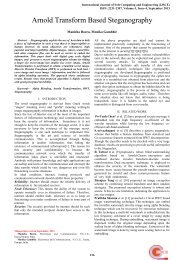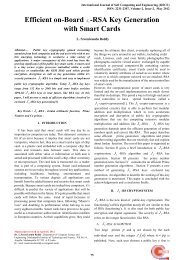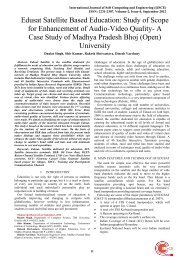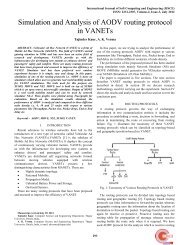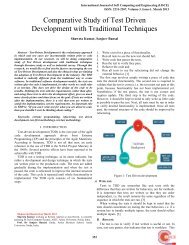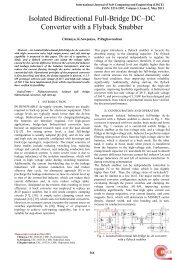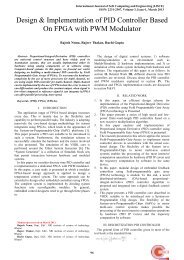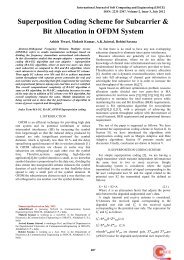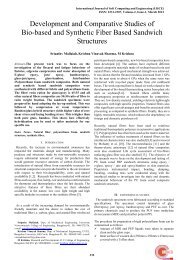Application of ICT in Crop Production - International Journal of Soft ...
Application of ICT in Crop Production - International Journal of Soft ...
Application of ICT in Crop Production - International Journal of Soft ...
You also want an ePaper? Increase the reach of your titles
YUMPU automatically turns print PDFs into web optimized ePapers that Google loves.
<strong>International</strong> <strong>Journal</strong> <strong>of</strong> S<strong>of</strong>t Comput<strong>in</strong>g and Eng<strong>in</strong>eer<strong>in</strong>g (IJSCE)<br />
ISSN: 2231-2307, Volume-2, Issue-4, September 2012<br />
<strong>Application</strong> <strong>of</strong> <strong>ICT</strong> <strong>in</strong> <strong>Crop</strong> <strong>Production</strong><br />
Ugwuishiwu C.H, Udanor C., Ugwuishiwu B.O<br />
Abstract - The rapid advancement <strong>in</strong> Information and<br />
Communications Technologies (<strong>ICT</strong>s) has given rise to new<br />
applications that were impossible just few years ago. Agriculture is<br />
an important sector with the majority <strong>of</strong> the rural population <strong>in</strong><br />
develop<strong>in</strong>g countries depend<strong>in</strong>g on it. The sector faces major<br />
challenges <strong>of</strong> enhanc<strong>in</strong>g production <strong>in</strong> a situation <strong>of</strong> dw<strong>in</strong>dl<strong>in</strong>g<br />
natural resources necessary for production. <strong>ICT</strong> plays an<br />
important role <strong>in</strong> challeng<strong>in</strong>g and uplift<strong>in</strong>g the livelihoods <strong>of</strong> the<br />
rural populace us<strong>in</strong>g an agro computer-based <strong>in</strong>formation system.<br />
This paper proposes an Agro-Information System that enables a<br />
farmer to have relevant <strong>in</strong>formation about a crop, such as the<br />
varieties and other requirements like soil type, temperature, type<br />
and quantity <strong>of</strong> fertilizer, time <strong>of</strong> plant<strong>in</strong>g, time <strong>of</strong> maturity,<br />
plant<strong>in</strong>g distance, diseases, pest, pest and Disease control<br />
measures, ra<strong>in</strong>fall, sunsh<strong>in</strong>e, etc. <strong>of</strong> that crop. The level <strong>of</strong><br />
application <strong>of</strong> this <strong>in</strong>formation determ<strong>in</strong>es the volume and<br />
efficiency <strong>of</strong> the crop yield. An AIS s<strong>of</strong>tware is designed and<br />
implemented which helps the farmer achieve the afore-mentioned<br />
objectives.<br />
Keywords: Agriculture, <strong>Crop</strong> yield, <strong>ICT</strong>, <strong>Crop</strong> requirements,<br />
Agro Information System (AIS).<br />
I. INTRODUCTION<br />
There is an ever-<strong>in</strong>creas<strong>in</strong>g use <strong>of</strong> <strong>in</strong>formation <strong>in</strong> all aspects<br />
<strong>of</strong> human activities <strong>in</strong>clud<strong>in</strong>g agriculture. Because <strong>of</strong> the<br />
urgent need for research <strong>in</strong> the proper use <strong>of</strong> new<br />
technologies <strong>in</strong> Agriculture, knowledge produced by<br />
Agricultural scientists must be transformed <strong>in</strong>to computer<br />
understandable representation. It is based on this background<br />
that this study has been undertaken to illustrate an application<br />
<strong>of</strong> <strong>ICT</strong> <strong>in</strong> crop production. Agriculture is the art and science<br />
<strong>of</strong> all bus<strong>in</strong>ess related to grow<strong>in</strong>g <strong>of</strong> crops and rear<strong>in</strong>g <strong>of</strong><br />
animals for the provision <strong>of</strong> food, shelter and <strong>in</strong>creas<strong>in</strong>g <strong>of</strong><br />
the standard <strong>of</strong> liv<strong>in</strong>g for mank<strong>in</strong>d [1]. The importance <strong>of</strong><br />
Agriculture <strong>in</strong>cludes provision <strong>of</strong> food, employment and raw<br />
materials for <strong>in</strong>dustries, others are, foreign exchange earner,<br />
source <strong>of</strong> <strong>in</strong>come, provision <strong>of</strong> shelter, regional development<br />
and afforestation.<br />
The agricultural sector is confronted with the major<br />
challenge <strong>of</strong> <strong>in</strong>creas<strong>in</strong>g production to feed a grow<strong>in</strong>g and<br />
<strong>in</strong>creas<strong>in</strong>gly prosperous population <strong>in</strong> a situation <strong>of</strong><br />
decreas<strong>in</strong>g availability <strong>of</strong> natural resources [2]. Farm<strong>in</strong>g<br />
<strong>in</strong>volves risks and uncerta<strong>in</strong>ties, with farmers fac<strong>in</strong>g many<br />
threats from water shortages, decl<strong>in</strong><strong>in</strong>g soil fertility, erosion,<br />
pests, effects <strong>of</strong> climate change and rapid decrease <strong>of</strong> fertile<br />
agricultural lands due to urbanization. There is a huge gap<br />
between <strong>in</strong>formation resid<strong>in</strong>g <strong>in</strong> agricultural knowledge<br />
centres and rural communities. Information on pest and<br />
disease control, especially early warn<strong>in</strong>g systems, new<br />
varieties, new ways to optimize production and regulations<br />
for quality control should help us <strong>in</strong> arrest<strong>in</strong>g these<br />
bottlenecks. This gave rise for the need for Information and<br />
communication technology <strong>in</strong> crop production.<br />
Manuscript received on September, 2012<br />
Ugwuishiwu C.H. Department <strong>of</strong> Computer Science, University <strong>of</strong><br />
Nigeria, Nsukka,<br />
Udanor C.N. Department <strong>of</strong> Computer Science, University <strong>of</strong> Nigeria,<br />
Ugwuishiwu B.O. Department <strong>of</strong> Agricultural & Bioresources<br />
Eng<strong>in</strong>eer<strong>in</strong>g, Nsukka, Nigeria,<br />
A farmer who has access to the most current <strong>in</strong>formation<br />
about his farm<strong>in</strong>g bus<strong>in</strong>ess must always be far ahead <strong>of</strong> those<br />
who lack <strong>in</strong>formation. Consider a farmer who has problem to<br />
solve <strong>in</strong> crop protection; <strong>in</strong>stead <strong>of</strong> walk<strong>in</strong>g from section to<br />
section <strong>of</strong> a library, the user is just guided on the screen to the<br />
different <strong>in</strong>formation stores by press<strong>in</strong>g few keys with the use<br />
<strong>of</strong> computer [3]. Investment must be promised on the<br />
knowledge <strong>of</strong> what is available, how accessible they are, how<br />
they are used and what capabilities exist or a need to be<br />
developed <strong>in</strong> us<strong>in</strong>g <strong>in</strong>formation technology.<br />
In a develop<strong>in</strong>g country like Nigeria, this can be done<br />
through the use <strong>of</strong> mobile phones, traditional media such as<br />
community radio or TV, computers, geographical<br />
<strong>in</strong>formation systems, pr<strong>in</strong>ted documents, e-mail, CD-Rom,<br />
SMS, or Internet, among others, to dissem<strong>in</strong>ate <strong>in</strong>formation<br />
that enable even small-scale farmers who are not literate to<br />
use <strong>ICT</strong>s. Structured System Development methodology was<br />
used <strong>in</strong> develop<strong>in</strong>g this <strong>in</strong>formation system. This<br />
methodology takes objective view <strong>of</strong> reality; provides<br />
elaborate plann<strong>in</strong>g guidel<strong>in</strong>es, techniques and case tools. The<br />
method <strong>in</strong>cludes iterative activities which mean if there is a<br />
problem <strong>in</strong> one stage one can look at the earlier or later<br />
stages to rectify the program. Section 2.0 reviews related<br />
literature; section 3.0 details a high-level set <strong>of</strong> requirements<br />
that the AIS must satisfy, the architecture <strong>of</strong> an Agro<br />
<strong>in</strong>formation system and the database <strong>of</strong> the system. Section<br />
4.0 outl<strong>in</strong>es the description and the implementation <strong>of</strong> a<br />
prototype for the AIS. F<strong>in</strong>ally section 5.0 presents some<br />
conclud<strong>in</strong>g remarks.<br />
II. REVIEW OF RELATED LITERATURE<br />
At the beg<strong>in</strong>n<strong>in</strong>g, computer technology was developed and<br />
seen as a powerful tool for calculation and preparation <strong>of</strong><br />
documents. At the same time, communication technologies<br />
were also be<strong>in</strong>g developed for transfer <strong>of</strong> <strong>in</strong>formation from<br />
one location to the other. Somewhere along the l<strong>in</strong>e, a<br />
marriage occurred between the two technologies to give birth<br />
to <strong>in</strong>formation and communication technology (<strong>ICT</strong>)<br />
sometime referred to as simply (IT) [4]. Agriculture and<br />
rural development is undergo<strong>in</strong>g new and rapid changes due<br />
to globalization and new technologies that transform the way<br />
<strong>in</strong> which production is organized [5]. There is no universally<br />
accepted def<strong>in</strong>ition <strong>of</strong> <strong>ICT</strong> because the concepts, methods<br />
and applications <strong>in</strong>volved <strong>in</strong> <strong>ICT</strong> are constantly evolv<strong>in</strong>g on<br />
an almost daily basis. It happens so fast that it is difficult to<br />
keep up with the changes. <strong>ICT</strong> is def<strong>in</strong>ed here to cover any<br />
product that will store, retrieve, manipulate, transmit or<br />
receive <strong>in</strong>formation electronically <strong>in</strong> a digital form, for<br />
example, personal computers, digital television, email, robots<br />
etc [6]. E-Agriculture <strong>in</strong>volves the conceptualization, design,<br />
development, evaluation and application <strong>of</strong> <strong>in</strong>novative ways<br />
to use <strong>in</strong>formation and communication technologies (IT) <strong>in</strong><br />
the rural doma<strong>in</strong>, with a primary focus on agriculture [7].<br />
In several develop<strong>in</strong>g countries, <strong>ICT</strong>s represents the fastest<br />
grow<strong>in</strong>g <strong>in</strong>dustries and are assum<strong>in</strong>g grow<strong>in</strong>g<br />
macroeconomic importance. One <strong>of</strong> the major reasons <strong>of</strong> the<br />
current underdevelopment and poverty problems <strong>in</strong> African<br />
is lack <strong>of</strong> a sound technological base on which susta<strong>in</strong>able<br />
227
<strong>Application</strong> <strong>of</strong> <strong>ICT</strong> <strong>in</strong> <strong>Crop</strong> <strong>Production</strong><br />
development can stand [8]. At present, <strong>ICT</strong> is restricted to<br />
only the urban centres <strong>of</strong> the countries, yet statistics has it that<br />
about 70% <strong>of</strong> the citizens <strong>of</strong> develop<strong>in</strong>g countries are liv<strong>in</strong>g<br />
<strong>in</strong> rural areas.<br />
<strong>Application</strong> <strong>of</strong> <strong>ICT</strong> <strong>in</strong> crop production though a relatively<br />
new phenomenon, evidence <strong>of</strong> the contribution <strong>of</strong> <strong>ICT</strong> to<br />
agricultural development and poverty alleviation is becom<strong>in</strong>g<br />
<strong>in</strong>creas<strong>in</strong>gly obvious. [9] Some common problems <strong>in</strong><br />
adoption <strong>of</strong> <strong>ICT</strong> <strong>in</strong> rural segments such as <strong>ICT</strong> illiteracy,<br />
unavailability <strong>of</strong> relevant and localized contents <strong>in</strong> their own<br />
languages, uneasy and unaffordable accessibility and other<br />
issues like awareness and will<strong>in</strong>gness for adoption <strong>of</strong> new<br />
technologies among the rural peoples can def<strong>in</strong>itely be<br />
handled with the application <strong>of</strong> <strong>ICT</strong>. [10].<br />
Rural area is synonymous with agriculture because what<br />
affects rural development affects Agriculture. Thus for<br />
technology to have serious impact <strong>in</strong> develop<strong>in</strong>g countries, it<br />
must be made available to the rural area [11]. Information<br />
technology capabilities relate to the knowledge and skills<br />
required to effectively utilize communication equipment and<br />
correctly receive and transmit <strong>in</strong>formation up and down the<br />
channel <strong>of</strong> adm<strong>in</strong>istrative command [12]. The author also<br />
mentioned that IT capabilities consist <strong>of</strong> the resources needed<br />
to generate and manage <strong>in</strong>formation. <strong>ICT</strong> is also local<br />
<strong>in</strong>termediaries serv<strong>in</strong>g farmers who lack basic access to<br />
up-to-date <strong>in</strong>formation on best farm<strong>in</strong>g practices, market<br />
conditions, pest and disease control, weather forecasts, and a<br />
range <strong>of</strong> other issues [2].<br />
<strong>Application</strong> <strong>of</strong> <strong>ICT</strong> <strong>in</strong> Agriculture <strong>in</strong>volves focus<strong>in</strong>g on the<br />
enhancement <strong>of</strong> agricultural and rural development; this<br />
<strong>in</strong>volves application <strong>of</strong> <strong>in</strong>novative ways to use <strong>ICT</strong> <strong>in</strong> the<br />
rural doma<strong>in</strong>. The advancements <strong>in</strong> <strong>ICT</strong> can be utilized for<br />
provid<strong>in</strong>g accurate, timely, relevant <strong>in</strong>formation and services<br />
to the farmers, thereby facilitat<strong>in</strong>g an environment for more<br />
remunerative agriculture [10]. Taken <strong>in</strong>to account <strong>of</strong> the tides<br />
and trends that the research carried out <strong>in</strong> this area ended only<br />
<strong>in</strong> theory, therefore, this research will base on the design and<br />
implementation <strong>of</strong> an <strong>in</strong>formation system for crop production<br />
awareness to farmers.<br />
unless there is an improved version <strong>of</strong> the orig<strong>in</strong>al<br />
<strong>in</strong>formation.<br />
6. Verifiability: Farmer can also verify that the<br />
<strong>in</strong>formation they got is correct by go<strong>in</strong>g back to the site<br />
the second time or more.<br />
7. General: All farmers must be able to have access to the<br />
<strong>in</strong>formation system.<br />
B. Architecture <strong>of</strong> the Agro- Information System<br />
To accommodate the requirements presented <strong>in</strong> section 2.1<br />
above, architecture <strong>of</strong> the system was developed as shown <strong>in</strong><br />
fig.1.0 below. The system architecture def<strong>in</strong>es the key<br />
components <strong>of</strong> the proposed system together with the<br />
<strong>in</strong>teractions between these components. The system was<br />
modeled <strong>in</strong> a way that when a user want to view <strong>in</strong>formation<br />
<strong>in</strong> the system, the user has to enter a name <strong>of</strong> a particular<br />
crop, from there he selects the variety <strong>of</strong> the crop, and view<br />
the requirements <strong>of</strong> that variety. The developed system<br />
allows many farmers to use it simultaneously while ensur<strong>in</strong>g<br />
high availability any time the <strong>in</strong>formation is needed. For<br />
security purposes, update module can only be accessed by an<br />
Adm<strong>in</strong>istrator us<strong>in</strong>g an identity code. Below is architecture<br />
<strong>of</strong> the agro <strong>in</strong>formation system.<br />
III. THE AGRO-INFORMATION SYSTEM ANALYSIS<br />
This section shows a number <strong>of</strong> criteria that the design <strong>of</strong><br />
the system will satisfy. It also discussed the architecture <strong>of</strong><br />
the entire system and the data design.<br />
A. Requirements Def<strong>in</strong>ition for the Agro Information<br />
System<br />
The design <strong>of</strong> this system satisfies a number <strong>of</strong> sometimes<br />
compet<strong>in</strong>g criteria. These requirements are:<br />
1. Security: The <strong>in</strong>formation stored <strong>in</strong> the system cannot<br />
be tampered with unless by the adm<strong>in</strong>istrator when the<br />
need for update arises.<br />
2. Multi-user: A number <strong>of</strong> farmers can access the system<br />
simultaneously through the Internet.<br />
3. Accessibility: The system can be accessed by farmers<br />
from any location us<strong>in</strong>g secure <strong>in</strong>ternet and or mobile<br />
devices.<br />
4. Availability: The system is readily available to users<br />
through the Internet, mobile phones, and traditional<br />
media among others.<br />
5. Integrity/accuracy: Every <strong>in</strong>formation <strong>in</strong> the system<br />
comes from pr<strong>of</strong>essionals (those knowledgeable <strong>in</strong> field)<br />
and must have been tested and confirmed through<br />
scientific experiment. No alternation to this is permitted<br />
Fig. 1: The Architecture <strong>of</strong> the Agro-Information System<br />
C. Database<br />
Database has the core service for stor<strong>in</strong>g, process<strong>in</strong>g and<br />
secur<strong>in</strong>g data. The database server provides controlled access<br />
and rapid transaction process<strong>in</strong>g to meet the requirements <strong>of</strong><br />
the client tier. Information on all crop records, crop variety<br />
records and each crop variety requirements record resides <strong>in</strong><br />
this server as shown <strong>in</strong> Tables 1 and 2. The server is also<br />
responsible for authenticat<strong>in</strong>g adm<strong>in</strong>istrators authorization<br />
and the system when the need be. The relationships between<br />
the entities <strong>in</strong> the Tables mentioned above are also shown <strong>in</strong><br />
fig. 2.0.<br />
Table ia: All <strong>Crop</strong>s Tables<br />
Field name<br />
<strong>Crop</strong><br />
Botanical name<br />
Type<br />
<strong>Crop</strong> code<br />
Field type<br />
Text<br />
Text<br />
Text<br />
Text<br />
228
Table ib: When a user adds a new crop <strong>in</strong>to the table, a record<br />
will take the follow<strong>in</strong>g form<br />
Field name<br />
Field type<br />
<strong>Crop</strong><br />
Botanical<br />
Type<br />
<strong>Crop</strong> code<br />
Tomatoes<br />
Lycopersicon<br />
Vegetable<br />
Cp001<br />
Table iia: Varieties Requirements Table<br />
Field name<br />
Field type<br />
Varcode<br />
<strong>Crop</strong>code<br />
VarName<br />
Soil type<br />
Fertilizer type<br />
Temperature<br />
Text<br />
Text<br />
Text<br />
Text<br />
Text<br />
Text<br />
<strong>International</strong> <strong>Journal</strong> <strong>of</strong> S<strong>of</strong>t Comput<strong>in</strong>g and Eng<strong>in</strong>eer<strong>in</strong>g (IJSCE)<br />
ISSN: 2231-2307, Volume-2, Issue-4, September 2012<br />
Table iib: A record <strong>in</strong> table will consist <strong>of</strong> the follow<strong>in</strong>g:<br />
Field name<br />
Field type<br />
Varcode<br />
Var001<br />
<strong>Crop</strong>code<br />
Cp001<br />
VarName<br />
Ife plum<br />
Soil type<br />
Well dra<strong>in</strong>ed sandy<br />
loam<br />
Fertilizer type N.P.K. 15:15:15<br />
Temperature ( o c) 10-14<br />
Quantity<br />
<strong>of</strong> 550<br />
fertilizer(kg/ha/yr)<br />
Field name<br />
<strong>Crop</strong><br />
Botanical<br />
Type<br />
<strong>Crop</strong> code<br />
Quantity <strong>of</strong> fertilizer<br />
Time <strong>of</strong> plant<strong>in</strong>g<br />
Time <strong>of</strong> maturity<br />
Disease<br />
Pest<br />
Disease control<br />
Pest control<br />
Ra<strong>in</strong>fall<br />
Sunsh<strong>in</strong>e<br />
Time <strong>of</strong> plant<strong>in</strong>g<br />
Time <strong>of</strong> maturity<br />
Disease<br />
Pest<br />
Disease control<br />
Field type<br />
Tomatoes<br />
Lycopersicon<br />
Vegetable<br />
Cp001<br />
Text<br />
Text<br />
Text<br />
Text<br />
Text<br />
Text<br />
Text<br />
Text<br />
Text<br />
Jan-April<br />
9 months<br />
Eusarium wilt (Root<br />
Rot)<br />
Grasshopper<br />
Treat soil with copper<br />
Pest control<br />
Had pick<strong>in</strong>g<br />
Ra<strong>in</strong>fall(cm) 49-90<br />
Sunsh<strong>in</strong>e<br />
Very high<br />
IV. AGRO-INFORMATION SYSTEM<br />
IMPLEMENTATION<br />
The system architecture def<strong>in</strong>es the key components <strong>of</strong> the<br />
proposed system together with the <strong>in</strong>teractions between the<br />
components. The overall functional structure <strong>of</strong> the frame<br />
work is summarized as follows:<br />
A farmer who wants to <strong>in</strong>troduce a brand new crop <strong>in</strong>to his<br />
farm menu or who has already been farm<strong>in</strong>g on a particular<br />
type <strong>of</strong> crop can access the <strong>in</strong>formation about the crop by<br />
runn<strong>in</strong>g through the <strong>in</strong>formation system stored <strong>in</strong> the<br />
computer as follows:<br />
When the system is open, click on run, ma<strong>in</strong> menu form<br />
will appear compris<strong>in</strong>g FILE, VIEW, and UPDATE module.<br />
A. File Subsystem<br />
When you click on file, sub menu named “open” and<br />
“Exit” will appear, when you select open, another submenu<br />
will show “crop and variety”. When you select crop, an <strong>in</strong>put<br />
box will appear prompt<strong>in</strong>g you for a crop name, when you<br />
enter crop name that exist <strong>in</strong> database, a form named “AIS<br />
crop and variety” shown <strong>in</strong> one <strong>of</strong> the three forms <strong>in</strong> figure 3<br />
will appears which conta<strong>in</strong>s the crop you have selected, its<br />
varieties and requirement command button.<br />
When you click on “varieties <strong>of</strong> this crop”, varieties <strong>of</strong> the<br />
crop you have selected will appear, you select a variety, and<br />
then click on “see requirements”, the requirements <strong>of</strong> the<br />
variety you have selected will appear as shown <strong>in</strong> one <strong>of</strong> the<br />
three forms <strong>in</strong> figure 3 as “Red Banana” and this is the f<strong>in</strong>al<br />
output.<br />
When you select the variety submenu <strong>in</strong>stead <strong>of</strong> crop<br />
submenu, you will still go through the same process s<strong>in</strong>ce any<br />
variety should be under a crop name. Assum<strong>in</strong>g you do not<br />
want to open neither crop nor variety and select Exit, the<br />
program will close.<br />
B. Update Module<br />
It is only the adm<strong>in</strong>istrator that is authorized to make<br />
changes <strong>in</strong> the system either by add<strong>in</strong>g a new crop or variety,<br />
or by edit<strong>in</strong>g an already exist<strong>in</strong>g crops and varieties <strong>in</strong> the<br />
database. To add more crop(s), click on update and select<br />
‘add’, form named crop and variety will appear where you fill<br />
<strong>in</strong> the crop and click on update command button’, if it is<br />
229
<strong>Application</strong> <strong>of</strong> <strong>ICT</strong> <strong>in</strong> <strong>Crop</strong> <strong>Production</strong><br />
variety you want to add, select variety, add the crop and click<br />
on exit to close.<br />
To make changes on the exist<strong>in</strong>g crop, click on ‘Edit’, click<br />
on ‘crop’, enter a crop name <strong>in</strong> an <strong>in</strong>put box that appears,<br />
click ‘ok’, a form named crop and variety appears where you<br />
can make all changes on the crop, its variety and even on the<br />
requirements <strong>of</strong> the variety you have selected. You click on<br />
close to exit the program. You can also use variety code to<br />
edit variety by click<strong>in</strong>g on “edit submenu”,variety, enter<br />
variety code <strong>in</strong> the <strong>in</strong>put box and click “ok”, a form named<br />
AIS variety appears and you make your changes.<br />
C. View Module<br />
When you want to see all the exist<strong>in</strong>g crops and varieties<br />
and their codes, you use this menu. If you want to view all the<br />
exit<strong>in</strong>g crop types and their codes, you click on view, select<br />
crop types, a form conta<strong>in</strong><strong>in</strong>g all the exit<strong>in</strong>g crops will<br />
appear. You exit by click<strong>in</strong>g close. If it is all varieties that you<br />
want to view, then select view, click on the variety and all the<br />
exit<strong>in</strong>g varieties <strong>of</strong> all the exit<strong>in</strong>g crops differentiated by<br />
us<strong>in</strong>g variety’s crop codes will appear and you exit by<br />
click<strong>in</strong>g on close bottom. The follow<strong>in</strong>g (fig. 3) are some <strong>of</strong><br />
the forms <strong>in</strong> the Agro <strong>in</strong>formation system.<br />
Fig. 3 Some Major Forms <strong>of</strong> the Developed System<br />
V CONCLUSION AND FUTURE WORK<br />
S<strong>in</strong>ce we have seen the relevance <strong>of</strong> agriculture to mank<strong>in</strong>d,<br />
there is no doubt that we should improve crop production<br />
through technological advancement and <strong>in</strong>formation<br />
dissem<strong>in</strong>ation. Technology has emerged as a significant<br />
alternative to the conventional means <strong>in</strong> dissem<strong>in</strong>ation <strong>of</strong><br />
reliable and trusted <strong>in</strong>formation<br />
This paper detailed the requirements, design and<br />
implementation <strong>of</strong> a generic agro <strong>in</strong>formation system, where<br />
farmers can update themselves anytime, anywhere us<strong>in</strong>g a<br />
number <strong>of</strong> electronic devices <strong>in</strong>clud<strong>in</strong>g private computer<br />
networks, web and mobile phones. The AIS is sufficiently<br />
robust and comprehensible that farmers will get better return<br />
on their <strong>in</strong>vestments after us<strong>in</strong>g the system. The application<br />
<strong>of</strong> this system reduces the cost <strong>of</strong> adm<strong>in</strong>istration as the<br />
constra<strong>in</strong>t <strong>of</strong> time; resources and distances are reduced by the<br />
<strong>in</strong>stant communication possibilities <strong>of</strong> these technologies.<br />
The f<strong>in</strong>d<strong>in</strong>gs <strong>of</strong> this study brought to the fore, the limitless<br />
possibilities and various ways <strong>of</strong> us<strong>in</strong>g <strong>ICT</strong> <strong>in</strong> an aspect <strong>of</strong><br />
agricultural adm<strong>in</strong>istration and practice known as crop<br />
production.<br />
Future work will <strong>in</strong>corporate market <strong>in</strong>formation. This will<br />
be a big plus to the research because awareness <strong>of</strong> up-to-date<br />
market <strong>in</strong>formation on the prices <strong>of</strong> commodities, services<br />
and consumer trends can improve farmers’ livelihoods<br />
substantially. Such <strong>in</strong>formation is <strong>in</strong>strumental <strong>in</strong> mak<strong>in</strong>g<br />
decisions about future crops and commodities and about the<br />
best time and place to buy and sell goods. This <strong>in</strong>formation<br />
can be broadcast to the rural populace through electronic<br />
media such as radio, TV and mobile phones.<br />
REFERENCE<br />
[1] Anyanwu A.C; Anyanwu B.O.; Anyanwu V. A.(1999). A textbook <strong>of</strong><br />
Agriculture Sciencefor schools and colleges. Fifth Edition 1999.<br />
ISBN 975-175-350-1<br />
[2] Krishna Kumar P.S. Mapp<strong>in</strong>g & Prelim<strong>in</strong>ary Evaluation <strong>of</strong> <strong>ICT</strong><br />
<strong>Application</strong>s Support<strong>in</strong>g Agricultural Development retrieved from<br />
www.acdivoca.org/ accessed on 2 nd feb, 2012<br />
[3] Huggan, R.D.; E.D. Hunt; and M.C. Van den Berg (1994). From<br />
research through <strong>in</strong>formation… <strong>in</strong>to production In: New <strong>in</strong>formation<br />
technologies <strong>in</strong> agriculture, “Quarterly Bullet<strong>in</strong> <strong>of</strong> the <strong>International</strong><br />
Association <strong>of</strong> Agricultural Information Specialist”, Vol. XXIX No.<br />
1-2 pp 18-32.<br />
[4] Uguru, F.N.(2001). Information technology: Access capability and<br />
use among Adm<strong>in</strong>istrators <strong>of</strong> Agro-Technologies Transfer programmmes<br />
<strong>in</strong> South-Eastern Nigeria Ph.D Thesis.<br />
[5] Chowdhury, N. (2001). Appropriate technology, for Sta<strong>in</strong>able Food<br />
Security: <strong>ICT</strong>s. In P<strong>in</strong>strup- Anderson, P.(Ed) Appropriate<br />
technology for susta<strong>in</strong>able food security. 2020 Vision Focus7. IFPRI,<br />
Wash<strong>in</strong>gton DC.<br />
[6] What is <strong>ICT</strong> retrieved from<br />
tutor2u.net/bus<strong>in</strong>ess/ict/<strong>in</strong>tro_what_is_ict.htm - Cached accessed on<br />
3rd Feb, 2012<br />
[7] <strong>ICT</strong> <strong>in</strong> Agriculture retrieved from en.wikipedia.org/wiki/<br />
<strong>ICT</strong>_<strong>in</strong>_agriculture – Cached accessed on 2 nd Feb, 2012<br />
[8] Odigboh, E.U. and Onwualu, A.P. (1994). Mechanization <strong>of</strong><br />
Agriculture <strong>in</strong> Nigeria: a critical appraisal “<strong>Journal</strong> <strong>of</strong> Agricultural<br />
Technology” 2 (2): 1-58.<br />
[9] How <strong>ICT</strong> can make a difference <strong>in</strong> agricultural livelihoods retrieved<br />
from<br />
www.iicd.org/files/<strong>ICT</strong>%20and%20agricultural%20livelihoods.pdf<br />
accessed on 2 nd Feb, 2012<br />
[10] <strong>ICT</strong> <strong>in</strong> Agriculture retrieved from www.ekrish<strong>in</strong>aip.<strong>in</strong>/ - Cached<br />
accessed on 2 nd Feb, 2012<br />
[11] Ugwuishiwu C.H. (2004). <strong>Application</strong> <strong>of</strong> Information and<br />
Communication Technology <strong>in</strong> Agriculture. BSc. Project<br />
[12] Adey<strong>in</strong>ka, F.M.(1997).Technology response <strong>of</strong> firms to<br />
telecommunication development <strong>in</strong> Nigeria .An <strong>in</strong>terim project<br />
report submitted to the African Technology studies (ATPS), Ibadan:<br />
NISER.<br />
230
Chikodili H.Ugwuishiwu is a lecturer and research<br />
fellow <strong>in</strong> the Department <strong>of</strong> Computer Science,<br />
University <strong>of</strong> Nigeria, Nsukka. She holds a Masters<br />
Degree <strong>in</strong> Computer Science from University <strong>of</strong><br />
Nigeria Nsukka. She has advanced <strong>in</strong> her Ph.D work<br />
titled: Design and Development <strong>of</strong> real Time<br />
Integrated Crime Information System for Nigeria<br />
Law enforcement Agencies <strong>in</strong> Computer Science Department , University <strong>of</strong><br />
Nigeria, Nsukka. Her areas <strong>of</strong> research <strong>in</strong>terest are on Computer Information<br />
System(CIS) and S<strong>of</strong>tware development. She is a member <strong>of</strong> Computer<br />
Pr<strong>of</strong>essionals <strong>of</strong> Nigeria (CPN) with some journal publications.<br />
Coll<strong>in</strong>s N. Call<strong>in</strong>gs Udanor received his Bachelor <strong>of</strong><br />
Eng<strong>in</strong>eer<strong>in</strong>g Degree <strong>in</strong> Computer Science &<br />
Eng<strong>in</strong>eer<strong>in</strong>g, Enugu State University <strong>of</strong> Science &<br />
Technology (ESUT) <strong>in</strong> 1996. He got his Masters<br />
Degree <strong>in</strong> 2004 <strong>in</strong> Computer Science from University<br />
<strong>of</strong> Nigeria Nsukka. He is conclud<strong>in</strong>g his PhD work <strong>in</strong><br />
Electronic Eng<strong>in</strong>eer<strong>in</strong>g Department UNN, await<strong>in</strong>g<br />
f<strong>in</strong>al assessment. His research areas <strong>in</strong>clude: Agent-based <strong>in</strong>telligent mobile<br />
learn<strong>in</strong>g systems, Grid High Performance & Cloud Comput<strong>in</strong>g. He has many<br />
years <strong>of</strong> pr<strong>of</strong>essional hands-on experience <strong>in</strong> the <strong>in</strong>dustry and academic<br />
projects. He is versatile <strong>in</strong> many programm<strong>in</strong>g languages, as well as <strong>in</strong><br />
different hardware platforms. He has developed so many onl<strong>in</strong>e and mobile<br />
applications. He has also authored many academic books and has<br />
publications <strong>in</strong> <strong>in</strong>ternational journals. C.N.C Udanor currently is faculty<br />
member <strong>in</strong> UNN and also a member <strong>of</strong> Computer Pr<strong>of</strong>essionals <strong>of</strong> Nigeria<br />
(CPN).<br />
Boniface Obi UGWUISHIWU is a senior Lecturer <strong>in</strong><br />
the Department <strong>of</strong> Agricultural and Bioresources<br />
Eng<strong>in</strong>eer<strong>in</strong>g, Faculty <strong>of</strong> Eng<strong>in</strong>eer<strong>in</strong>g, University <strong>of</strong><br />
Nigeria, Nsukka. He has Masters` and Doctorate<br />
degrees from the Department <strong>of</strong> Agricultural and<br />
Bioresources Eng<strong>in</strong>eer<strong>in</strong>g., University <strong>of</strong> Nigeria,<br />
Nsukka. His research <strong>in</strong>terests are on Agricultural Farm<br />
Structures and Design, Agricultural Waste Management and Environmental<br />
Control, Susta<strong>in</strong>able Agricultural and Bioresources Development, Natural<br />
Resources Management, Appropriate Technology and Gender issue. He is a<br />
coperate member <strong>of</strong> Nigerian Institution <strong>of</strong> Agricultural Eng<strong>in</strong>eers (MNIAE),<br />
Member, Nigerian Society <strong>of</strong> Agricultural Eng<strong>in</strong>eers (MNSE), Council <strong>of</strong><br />
Registered Eng<strong>in</strong>eers <strong>of</strong> Nigeria (COREN), and Member, American Society <strong>of</strong><br />
Agricultural and Bioresources Eng<strong>in</strong>eers(MASABE) He has over twenty<br />
publications <strong>in</strong> both <strong>International</strong> and national journals.<br />
<strong>International</strong> <strong>Journal</strong> <strong>of</strong> S<strong>of</strong>t Comput<strong>in</strong>g and Eng<strong>in</strong>eer<strong>in</strong>g (IJSCE)<br />
ISSN: 2231-2307, Volume-2, Issue-4, September 2012<br />
231



